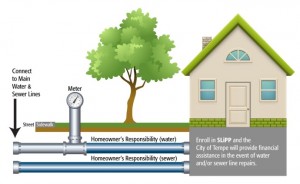 Guest author Catherine Noyes is an Associate Consultant at Raftelis Financial Consultants.
Guest author Catherine Noyes is an Associate Consultant at Raftelis Financial Consultants.
Since October, 2010, the Houston-Galveston area has suffered from one of the worst droughts on record. According to the Area Council’s Clean Rivers Program, by the end of 2011, the City of Houston had repaired 17,756 water line breaks, up from 10,821 in 2010. Given that July, 2012 was the hottest month in 117 years of records, it’s not surprising that water service utilities around the country are struggling to keep up with the drought damage impacting buried infrastructure. This damage includes anything from soil shifting as it dries out, to tree roots working their way into pipes in search of moisture.
Depending on where these breaks occur, homeowners may be responsible for shouldering the financial burden of repair or replacement – often at a cost of thousands of dollars. Many homeowners may not know that they are responsible for both the water line that runs from their home to the city’s water meter, and for the sewer line that runs from their home to the city’s sewer main. Through line protection programs, homeowners have a chance to mitigate the significant financial cost that can accompany standard emergency line replacement or repair, which homeowner’s insurance may not cover.
At the same time, water utilities across the country are looking for additional revenue sources to make up for revenue lost due to declining per capita consumption. Therefore, providing an opportunity for homeowners to acquire water and/or sewer line protection can be a win-win for utilities and their customers. Water and wastewater utilities can assist homeowners in combatting the costs associated with water line breaks while generating additional revenue for their systems. There are two approaches to utilities providing line protection. With some utilities, like the Louisville Water Company, operating line protection programs entirely through third-party providers, and others offering the program in-house. The second approach will be the subject of a later post, while third-party programs will be further examined here.
Under the third-party approach, a utility must carefully select an appropriate partner. The utility must have confidence that the partner will provide payouts under appropriate circumstances in a timely manner. Even though the utility may have no ability to impact the performance of the third party, negative reaction to the third party will impact perceived value of the utility.
Line protection can benefit utilities by giving them the opportunity to develop the program as an alternative revenue stream and reinvest any additional funds back into the system. The amount of revenue generated by third-party line protection programs varies, depending on a few factors. Line protection programs typically cost between $4.00 and $7.00 per utility line protected per month. For utilities that operate the programs through a third party, there are opportunities to generate revenue either through a percentage of royalties (Utility Service Partners, a third-party provider that operates in 45 states, offers a 10-12% royalty to partner utilities). Some cities have also chosen to license their seal or city logo to a third-party provider for additional revenue (Plano, TX charged Service Line Warranties of America a licensing fee of $63,730).
In addition to the alternative revenue stream, there are several other benefits for a water or wastewater utility offering this service. Wastewater utilities have incentive to minimize line breaks, as doing so helps to prevent groundwater infiltration into the wastewater system. Finally, offering line protection can help to address affordability issues that a utility’s service population may face. Repair or replacement costs for line breaks can cost thousands of dollars to repair, which could represent a serious problem for low-income customers. Some utilities, including Louisville Water Company, also use the proceeds of the line protection program to subsidize assistance programs for customers that struggle to pay their water bills.

